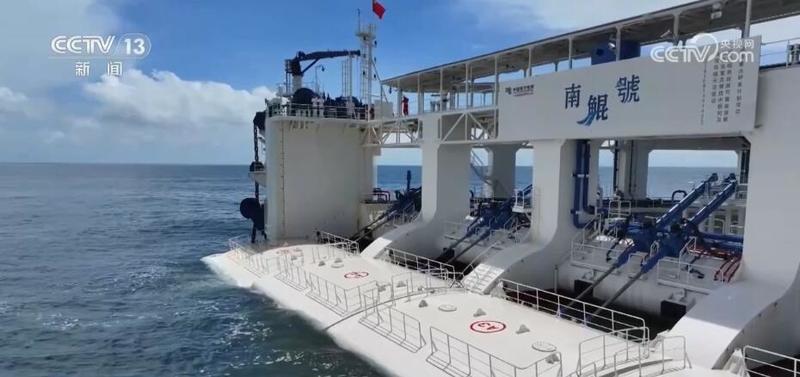 A photo of China's first independently developed megawatt-scale floating wave energy generation device "Nankun" in Zhuhai, Guangdong province, on June 15, 2023. (PHOTO / NEWS.CCTV.COM)
A photo of China's first independently developed megawatt-scale floating wave energy generation device "Nankun" in Zhuhai, Guangdong province, on June 15, 2023. (PHOTO / NEWS.CCTV.COM)
The development of the nation's offshore renewable energy made a leap forward on Wednesday as the country's first independently developed megawatt-scale floating wave energy generation device "Nankun" began trial operations in Zhuhai, Guangdong province.
The event signals the application of China's cutting-edge megawatt-scale wave energy generation technology in practical engineering, injecting fresh impetus into the country's offshore new energy development, experts said.
According to China Southern Power Grid, the device's lead developer, the entire device weighs 6,000 metric tons. It can generate up to 24,000 kilowatt-hours of electricity per day, which is equivalent to the daily electricity consumption of 3,500 households.
Wave energy, as a renewable energy source in oceans, harnesses the potential energy of the up-and-down motion of waves and the force of their back-and-forth movement to drive generators to produce electricity.
Known as a large "mobile power bank" for offshore power consumption areas, the wave energy facility has advantages in regions that are difficult to connect to power grids such as remote offshore islands, experts said.
Liu Shi, chief technical expert at China Southern Power Grid Technology Co Ltd, said that the device consists of a semi-submersible platform, a hydraulic system, a power generation system, a control system and a mooring system. By "absorbing" the waves with the semi-submersible platform and utilizing their energy through the independently developed energy conversion system, the device achieves a three-stage energy conversion from wave energy to hydraulic energy and then to electricity.
Liu said that at present, wave energy generation devices from home and abroad have capacities of only a few hundred kilowatts, and this megawatt-scale wave energy generation system represents a significant advancement in China's development of wave energy technology.
Experts said that the rapid development of wave energy will not only provide clean power for remote offshore islands but also have a wide range of applications such as supporting marine observations, seawater desalination and treatment, offshore hydrogen production and deep-sea aquaculture.
Lin Boqiang, head of the China Institute for Studies in Energy Policy at Xiamen University, said that although wave energy has broad prospects for development, the industry still faces several challenges in technological advancements and cost reduction. "Many wave energy generation facilities are still in the trial stage of operation. There is still some distance to go before commercial applications can be realized."
In addition, further efforts are still needed to improve conversion efficiency due to the high fluctuations of sea waves. Moreover, turbulent waves also make it challenging to design a device that can withstand storms while reliably generating power, experts said.
In recent years, China has intensified its efforts in developing clean energy by harnessing the power of the ocean. The country's installed capacity of offshore wind power ranked tops in the world as of 2021, according to the China Electricity Council.
Data from the National Energy Administration showed that as of the first quarter of this year, total installed capacity of offshore wind power in China reached 30.89 million kW.
In April, the NEA said the development of coastal nuclear power and offshore wind power will be accelerated. In the same month, a guideline issued by the NEA indicated plans to construct offshore wind power bases and initiate the construction of offshore photovoltaic projects.
Chinese companies are also stepping up efforts in the field. Xinjiang Goldwind Science & Technology Co Ltd said on Wednesday that a set of three 123-meter-long offshore wind turbine blades with 100 percent independent intellectual property rights has been readied in Lianyungang, Jiangsu province, for shipment to an offshore wind farm in Pingtan, Fujian province.


